Key takeaways:
- Vintage toys are nostalgic artifacts that connect us to our childhood and reflect the cultural context of their time.
- Restoration of toys is not only a means of preserving memories but also fosters emotional healing and personal growth.
- Proper tools and techniques are essential for successful restoration, enhancing the connection to the stories each toy holds.
- The future of vintage toy collecting is bright, with new generations discovering their value, further supported by technology and sustainability trends.

Understanding Vintage Toys
Vintage toys are more than just playthings; they are nostalgic relics that carry echoes of our childhood. I remember opening a dusty box at my parents’ house, discovering a wooden train set I hadn’t seen in years. Holding that simple toy again, I felt a wave of joy and memories wash over me—who knew something so small could encapsulate so many emotions?
Understanding vintage toys is about delving into the stories they tell. Each toy has a unique history attached to it, reflecting the cultural and social context of its time. Have you ever considered how a classic action figure influenced not just children, but the entertainment industry itself? It fascinated me to learn how these toys shaped generations’ imaginations while also sparking trends in popular culture.
The craftsmanship of older toys often highlights a dedication to quality that feels lacking in many modern products. I can’t help but marvel at the intricate details of a metal toy car I used to own. When I restored it, I experienced firsthand how these toys were built to last, representing a time when play was as much about tactile engagement as it was about innovation. This craftsmanship often carries with it a level of care and artistry that many consumers today may overlook.
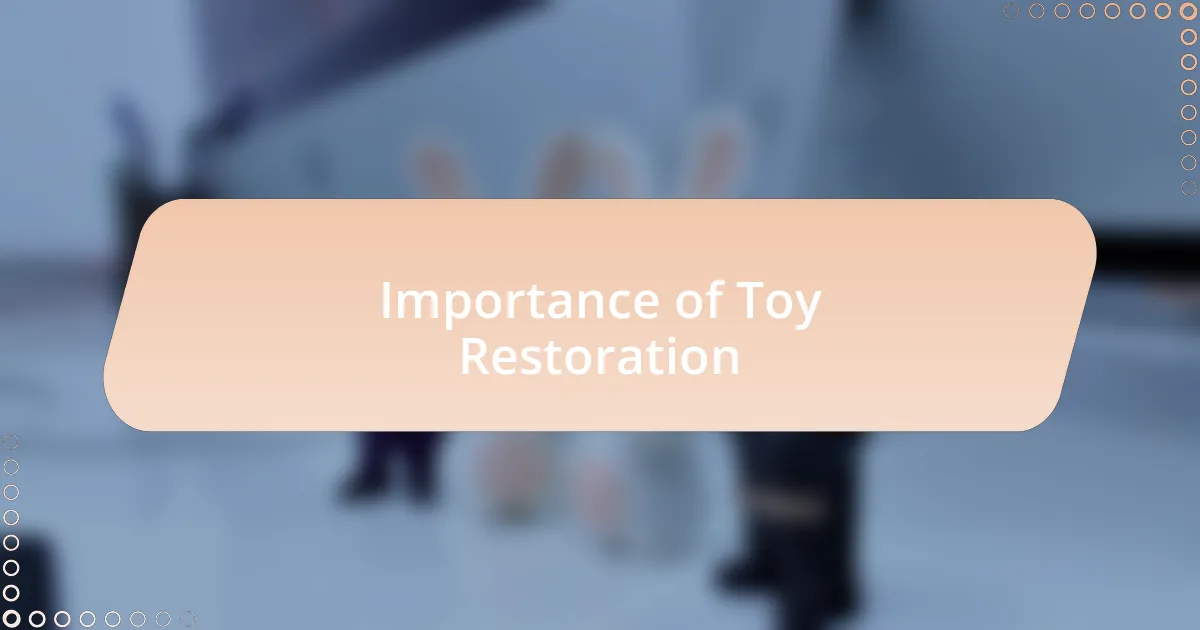
Importance of Toy Restoration
Restoring toys isn’t just about bringing back a piece of my childhood; it’s about preserving a legacy. When I worked on my sibling’s old dollhouse, I found myself not only repairing its structure but also reconnecting with memories of playtime spent together. Each brush of paint and replacement window reminded me of laughter shared, underscoring how these toys can hold families together across generations.
The emotional impact of restored toys is profound. I once gifted a lovingly restored action figure to a friend, and the tears in his eyes when he saw it spoke volumes. He recalled how that specific toy helped him through tough times as a child. How incredible is it that a simple object can evoke such powerful feelings? It’s a testament to the idea that our beloved toys are not just items; they are vessels of cherished memories and emotional healing.
Moreover, restoration can teach valuable lessons about patience and care. Each time I restore a vintage toy, I reflect on the importance of taking the time to appreciate craftsmanship. In a fast-paced world, spending hours meticulously repairing a toy can be surprisingly therapeutic. Have you ever tackled a restoration project? I found that each challenge, whether figuring out how to replace a missing piece or cleaning years of dust, reinforces my connection to these toys and the stories they embody.
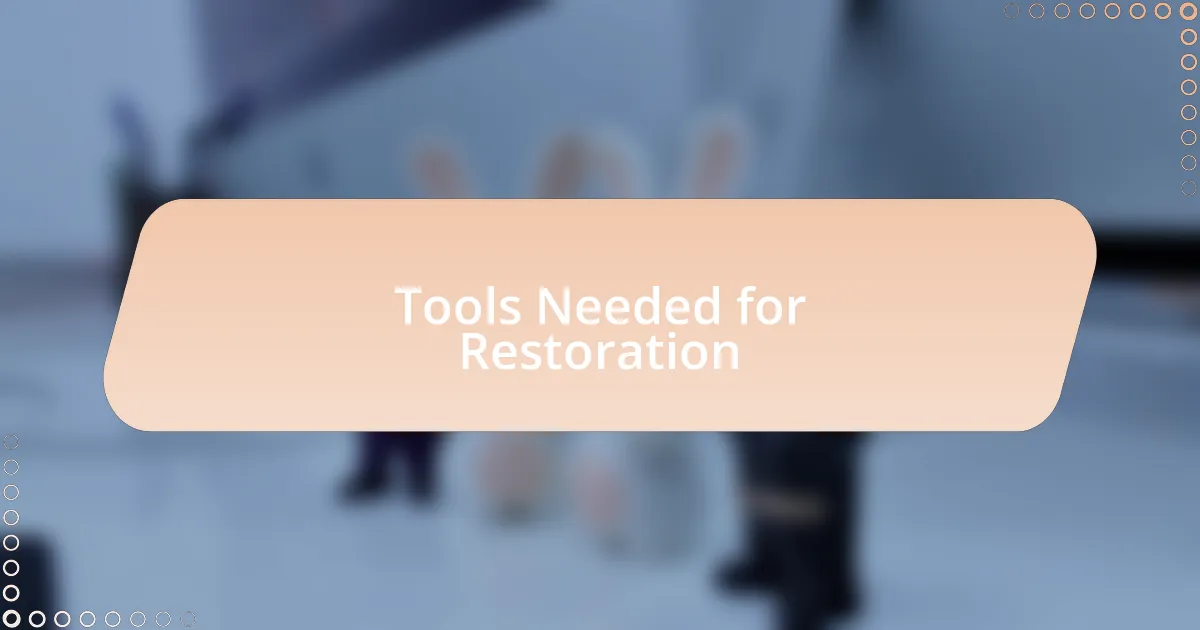
Tools Needed for Restoration
When it comes to restoring childhood toys, having the right tools is essential for a successful project. I often start with basic items like screwdrivers, pliers, and an assortment of brushes. These tools are not just practical; they also remind me of days spent tinkering in my father’s workshop, learning how every tool has its purpose.
For more intricate restorations, I’ve found that specialty tools can make all the difference. A rotary tool with various attachments became my best friend when I was tackling a weathered toy train, allowing me to smooth out rough areas that needed attention. Have you ever worked on a project where one specific tool transformed your experience? For me, that rotary tool turned a tedious task into a streamlined process, helping me preserve the train’s charm without compromising its integrity.
Don’t forget supplies like glue and paint specific to your toy’s material—these can significantly influence the final outcome. I learned the hard way when a restoration flopped because I didn’t use the right adhesive for plastic. The process turned frustratingly messy! However, these moments taught me valuable lessons that only deepened my connection to each toy, reminding me that restoration is about patience and learning just as much as it’s about the finished piece.
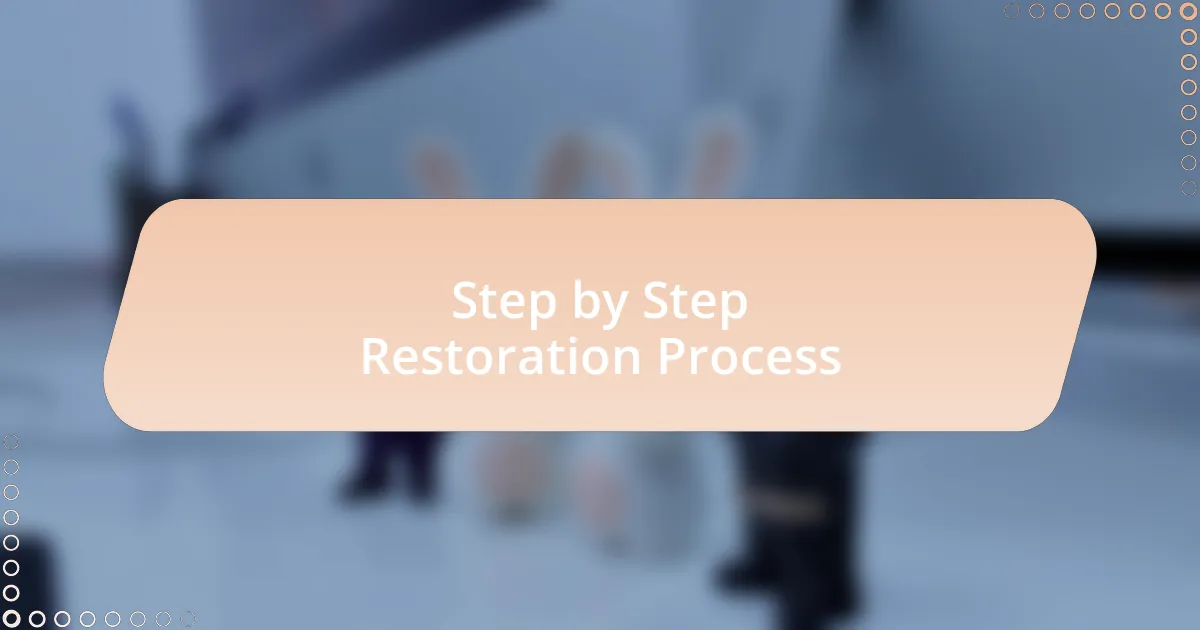
Step by Step Restoration Process
Restoring a childhood toy often begins with cleaning and assessing its condition. When I first tackled my old stuffed bear, I gently hand-washed it, reminiscing about how many adventures we had together. Have you ever felt a wave of nostalgia while bringing something back to life? That initial clean revealed hidden markings and wear that played a significant role in my choices for the restoration.
Next, I move on to repairing any damage. I recall a time when I had to sew back the button eyes on a classic action figure—something that seemed minor, yet it was crucial for retaining its character. I often ask myself how these small details could carry so much impact. They not only restore the toy’s functionality but also revive the stories they hold, bridging the gap between past and present.
Finally, finishing touches like repainting or sealing with a protective coating bring everything together. I once revitalized a vintage toy car by painting it with colors that matched my childhood memories, making it feel like a cherished keepsake once again. Isn’t it incredible how these small acts of restoration can evoke such strong emotions? Each brushstroke felt like rediscovering pieces of my own history, making the toy feel as vibrant today as it did when I first held it.

Personal Journey of Restoration
As I embarked on my restoration journey, I was often flooded with childhood memories. One particular evening, I found myself sitting on the floor, surrounded by colorful fabric swatches, attempting to recreate the original outfit for my old doll. The process ignited a creativity I hadn’t felt in years, prompting me to ask, how can something as simple as fabric connect us to our past?
Amid the restoration, I encountered several unexpected challenges. I remember struggling with a particularly stubborn scratch on my classic toy train. After hours of experimenting with various techniques, I finally discovered that sanding and polishing brought it back to life, turning my frustration into a satisfying revelation. This experience made me realize that restoration is not just a task; it’s a journey of patience and discovery, deeply intertwined with our personal histories.
Each completed toy felt like a chapter in my life being rewritten. I still vividly recall the moment I reattached a cherished wheel to my first toy robot, hearing that satisfying click. It made me reflect on the joy of childhood, and I couldn’t help but think: does restoring these toys bring more than just nostalgia? It seems to revive a part of ourselves that we often forget, reconnecting us with the child within.
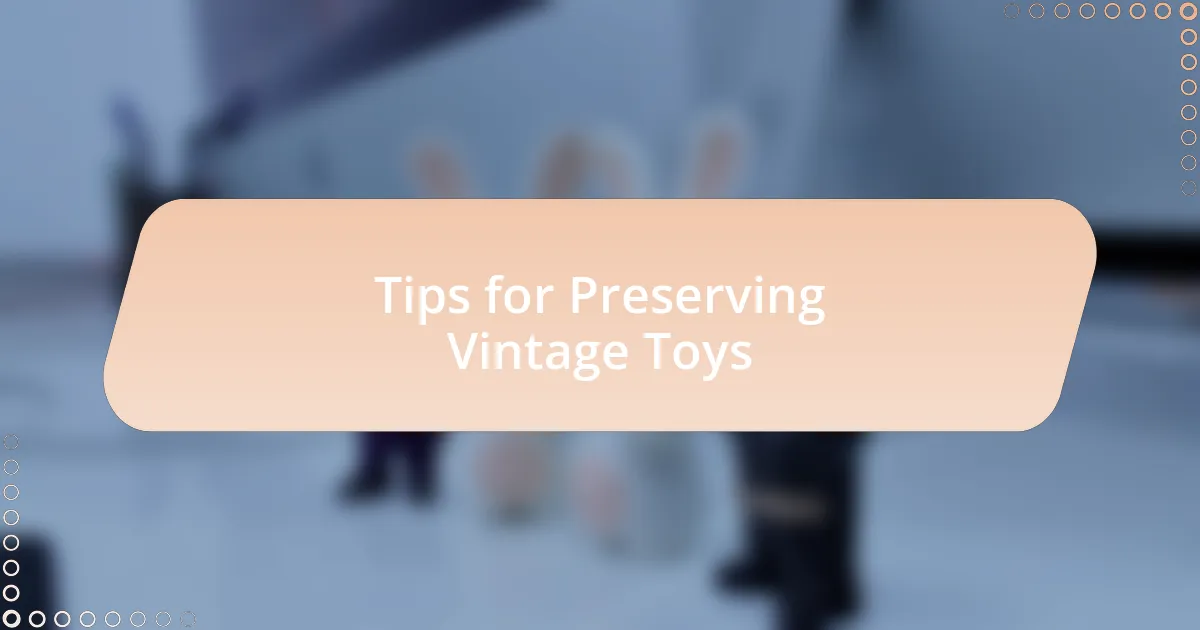
Tips for Preserving Vintage Toys
When it comes to preserving vintage toys, my first tip would be to store them in a controlled environment. I learned this the hard way when I left a toy soldier in my attic, only to find it warped by heat and humidity. Now, I keep my prized possessions in a cool, dry place, away from direct sunlight, ensuring they don’t fade or deteriorate over time.
I’ve also found that routine cleaning is crucial. Once, I neglected to dust off an old wind-up car, only to find it covered in grime that became stubbornly sticky. Regular gentle cleaning with a soft cloth can make all the difference in maintaining their charm and value. This small act not only preserves the toys but also allows me to connect with them more closely, evoking memories with every wipe.
Lastly, I encourage using archival quality materials for any repairs or display. I vividly remember replacing a broken part on my plush bear with a non-archival fabric, which caused it to wear unevenly. Using proper materials not only keeps the toys looking their best but also respects their history. After all, isn’t it our duty to honor the stories these vintage toys have to tell?
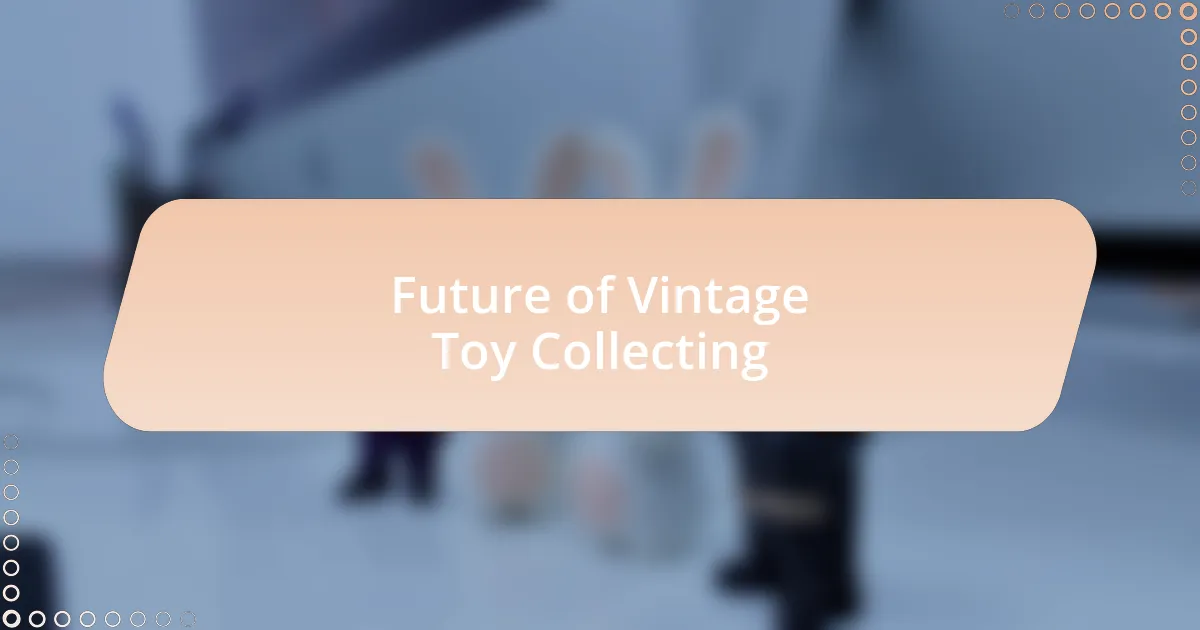
Future of Vintage Toy Collecting
The future of vintage toy collecting is undoubtedly promising, with new generations discovering the joy and nostalgia these toys bring. I still remember when a friend introduced me to a vintage toy fair; the excitement in the air was palpable. It was thrilling to see young collectors buzzing about toys that felt like cherished memories from my own childhood.
As technology advances, I’m curious to see how it will influence this hobby. Just the other day, I came across a virtual marketplace dedicated solely to vintage toys, where collectors can share stories and trade items with a global community. This digital shift not only increases accessibility but also deepens our connections with this treasured pastime.
Moreover, as sustainability becomes a greater concern, I find myself pondering whether vintage toys will be regarded as eco-friendly choices. After all, every toy has a history and their revival encourages a culture of reusing and cherishing rather than discarding. Isn’t there something beautifully fulfilling about giving old toys a new life?